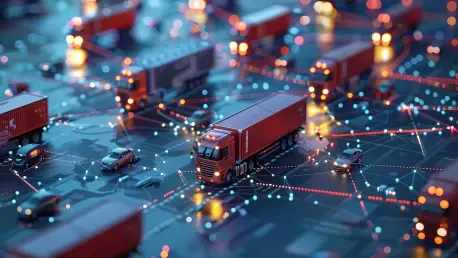Imagine a logistics industry where millions of trucks traverse vast distances daily, yet nearly a third of them run empty, wasting fuel, time, and resources in a sector worth trillions globally, highlighting a critical inefficiency that has long plagued supply chains. Digital freight platforms are stepping in as a transformative force, leveraging technology to connect shippers and carriers with unprecedented precision. These platforms are not just tools; they represent a fundamental shift in how goods move across continents, promising to redefine efficiency in an industry ripe for disruption. This review delves into the capabilities, impacts, and future potential of digital freight platforms, spotlighting their role in modern logistics.
Understanding the Core of Digital Freight Platforms
Digital freight platforms operate as technology-driven intermediaries that bridge the gap between shippers needing to transport goods and carriers offering transport services. At their essence, these platforms create digital marketplaces where real-time data and algorithms facilitate seamless connections, tackling age-old inefficiencies in a fragmented sector. Their emergence aligns with a broader push toward automation and data reliance in logistics, addressing pain points like mismatched loads and underutilized capacity.
The significance of these platforms extends beyond mere matchmaking. They bring transparency to a historically opaque industry, allowing stakeholders to track shipments, compare pricing, and optimize routes with a few clicks. In an economic landscape where cost reduction and speed are paramount, digital freight platforms stand as critical enablers of streamlined operations, positioning themselves as indispensable in the race for supply chain modernization.
Key Features and Technological Innovations
Freight Matching and Optimization Capabilities
One of the standout features of digital freight platforms lies in their ability to match shippers with carriers through sophisticated algorithms. These tools analyze variables like location, load size, and delivery timelines to pair parties efficiently, slashing the incidence of empty miles. The result is a marked improvement in load utilization, with some platforms reporting significant boosts in order fulfillment rates and user engagement metrics.
Beyond matching, optimization tools embedded in these platforms refine route planning and resource allocation. By minimizing downtime and fuel waste, they contribute to operational efficiency that benefits both shippers and carriers. This functionality not only cuts costs but also enhances reliability, making these platforms a cornerstone of modern freight management.
Integration of AI and Autonomous Technologies
Artificial intelligence plays a pivotal role in elevating the capabilities of digital freight platforms, powering predictive analytics for demand forecasting and dynamic pricing models. AI also supports features like trucker ratings, ensuring quality control and trust within the ecosystem. Such innovations create a competitive edge by enabling platforms to adapt swiftly to market fluctuations.
Additionally, the integration of autonomous driving technology is gaining traction, with investments aimed at deploying self-driving trucks to cut labor costs and improve safety. While real-world scalability remains a challenge due to regulatory and technical hurdles, early implementations show promise in reducing human error. The synergy of AI and autonomy signals a future where logistics could operate with minimal human intervention, reshaping industry cost structures.
Market Dynamics and Industry Shifts
The logistics sector is undergoing a profound transformation, with digital freight platforms at the forefront of this digitalization wave. Despite advancements, a significant portion of the industry still clings to manual processes, creating fertile ground for tech-driven solutions to gain traction. The push toward digital tools is fueled by consumer demand for faster, more transparent delivery systems, compelling companies to adapt or risk obsolescence.
Emerging trends like sustainability are also influencing platform adoption, as businesses seek to lower carbon footprints through optimized routing and load efficiency. AI-driven growth strategies further amplify this shift, enabling platforms to predict and respond to market needs with agility. These dynamics are reshaping industry behavior, positioning digital solutions as not just an option but a necessity for survival.
Practical Applications Across Industries
Digital freight platforms are making tangible impacts across diverse sectors, from manufacturing to retail and e-commerce. In manufacturing, they enhance supply chain visibility, allowing firms to track raw materials and finished goods in real time, thus reducing delays. Retail giants leverage these platforms to manage inventory distribution, ensuring shelves remain stocked amid fluctuating demand.
A unique application lies in serving underserved rural markets, where traditional logistics often falter due to low volumes and high costs. Platforms empower small-to-medium enterprises in these areas to access broader markets, leveling the playing field against larger competitors. Case studies reveal measurable outcomes, such as reduced delivery times and cost savings, underscoring the platforms’ value in niche scenarios.
Challenges Facing Digital Freight Platforms
Despite their promise, digital freight platforms encounter significant obstacles that temper their growth. High research and development costs for cutting-edge technologies like AI and autonomous systems strain financial resources, often impacting short-term profitability. Regulatory uncertainties surrounding autonomous vehicles further complicate deployment, delaying widespread adoption.
Technical challenges, including data security risks and the difficulty of integrating with legacy systems, also pose hurdles. Market competition adds pressure, with pricing wars threatening margins. However, strategic partnerships and advocacy for favorable policies are being pursued to mitigate these issues, reflecting a proactive approach to navigating a complex landscape.
Future Prospects and Innovations on the Horizon
Looking ahead, digital freight platforms are poised for breakthroughs that could redefine logistics. Advances in AI optimization are expected to further enhance matching accuracy and predictive capabilities, potentially slashing operational costs by significant margins between now and 2027. Autonomous freight solutions, if regulatory barriers ease, might revolutionize labor dynamics, reducing dependency on human drivers.
The long-term implications for global supply chains are profound, with potential to lower environmental impact through efficient routing and reduced empty runs. Societal benefits, such as decreased traffic congestion and emissions, could emerge as byproducts of this tech evolution. The trajectory suggests a logistics sector increasingly aligned with sustainability and innovation, driven by these platforms.
Final Reflections and Path Forward
Reflecting on the journey of digital freight platforms, their impact on logistics stands out as a beacon of efficiency and technological prowess in a traditionally cumbersome industry. Their ability to connect disparate players through digital means marks a turning point, while innovations in AI and autonomy hint at even greater transformations that have begun to unfold.
For stakeholders, the next steps involve strategic investments in technology to stay competitive, alongside collaboration with regulators to clear pathways for autonomous solutions. Businesses are encouraged to explore partnerships with platforms to unlock efficiency gains, while policymakers have a role in crafting frameworks that balance innovation with safety. The road ahead demands a collective effort to harness the full potential of digital freight, ensuring logistics evolves into a smarter, more sustainable engine of global trade.









